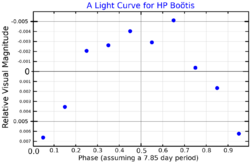Astronomy:HD 130948
| Observation data Equinox J2000.0]] (ICRS) | |
|---|---|
| Constellation | Boötes |
| Right ascension | 14h 50m 15.8112s[2] |
| Declination | +23° 54′ 42.639″[2] |
| Apparent magnitude (V) | 5.9949[3] |
| Characteristics | |
| Spectral type | G1V[4] |
| U−B color index | +0.01[5] |
| B−V color index | 0.576[3] |
| Variable type | BY Dra |
| Astrometry | |
| Radial velocity (Rv) | −1.5[6] km/s |
| Proper motion (μ) | RA: 143.91[3] mas/yr Dec.: 32.69[3] mas/yr |
| Parallax (π) | 55.03 ± 0.34[3] mas |
| Distance | 59.3 ± 0.4 ly (18.2 ± 0.1 pc) |
| Details | |
| Mass | 0.97[4] M☉ |
| Surface gravity (log g) | 4.18[4] cgs |
| Temperature | 5,780[4] K |
| Metallicity | [Fe/H] = -0.20[4] or 0.00[7] |
| Age | 4.7[8] or 0.5[7] Gyr |
| Other designations | |
| Database references | |
| SIMBAD | data |
HD 130948 or HP Boötis is a variable star with 2 brown dwarfs in the constellation Boötes. It has a stellar classification of G1V, which means it is a main sequence star with a mass and surface temperature that are similar to the Sun. The estimated age of this star is also similar to the Sun at 4.7 billion years (Gyr) old, but it has a lower proportion of elements (63%) other than hydrogen or helium. However, a separate study in 2009 gave a much younger age of 0.5 ± 0.3 Gyr and a higher metallicity that is very similar to the Sun.[7]
In 2002, a pair of co-orbiting brown dwarfs were discovered in orbit around this star. They were found using an adaptive optics instrument on the Gemini North 8m telescope in Hawaii.[9] The pair have a 10-year orbital period about the primary star, and their combined mass is 10.9% of the Sun's mass.[7]
The space velocity components of this star through the Milky Way galaxy are (U, V, W) = (−14.0, 14.7, −0.1).[4]
References
- ↑ Gaidos, E. J.; Henry, G. W.; Henry, S. M. (August 2000). "Spectroscopy and Photometry of Nearby Young Solar Analogs". The Astronomical Journal 120 (2): 1006–1013. doi:10.1086/301488. Bibcode: 2000AJ....120.1006G.
- ↑ 2.0 2.1 Perryman, M. A. C. (April 1997). "The HIPPARCOS Catalogue". Astronomy & Astrophysics 323: L49–L52. Bibcode: 1997A&A...323L..49P.
- ↑ 3.0 3.1 3.2 3.3 3.4 van Leeuwen, F. (November 2007). "Validation of the new Hipparcos reduction". Astronomy and Astrophysics 474 (2): 653–664. doi:10.1051/0004-6361:20078357. Bibcode: 2007A&A...474..653V.
- ↑ 4.0 4.1 4.2 4.3 4.4 4.5 Chen, Y. Q.; Nissen, P. E.; Zhao, G.; Zhang, H. W.; Benoni, T. (February 2000). "Chemical composition of 90 F and G disk dwarfs". Astronomy and Astrophysics Supplement 141 (3): 491–506. doi:10.1051/aas:2000124. Bibcode: 2000A&AS..141..491C.
- ↑ 5.0 5.1 "V* HP Boo -- Variable of BY Dra type". SIMBAD. Centre de Données astronomiques de Strasbourg. http://simbad.u-strasbg.fr/simbad/sim-id?Ident=HD+130948.
- ↑ Evans, D. S. (June 20–24, 1966). "The Revision of the General Catalogue of Radial Velocities". University of Toronto: International Astronomical Union. Bibcode: 1967IAUS...30...57E.
- ↑ 7.0 7.1 7.2 7.3 Dupuy, Trent J.; Liu, Michael C.; Ireland, Michael J. (February 2009). "Dynamical Mass of the Substellar Benchmark Binary HD 130948BC". The Astrophysical Journal 692 (1): 729–752. doi:10.1088/0004-637X/692/1/729. Bibcode: 2009ApJ...692..729D.
- ↑ Holmberg, J.; Nordstrom, B.; Andersen, J. (July 2009). "The Geneva-Copenhagen survey of the solar neighbourhood. III. Improved distances, ages, and kinematics". Astronomy and Astrophysics 501 (3): 941–947. doi:10.1051/0004-6361/200811191. Bibcode: 2009A&A...501..941H.
- ↑ Potter, Daniel; Martín, Eduardo L.; Cushing, Michael C.; Baudoz, Pierre; Brandner, Wolfgang; Guyon, Olivier; Neuhäuser, Ralph (March 2002). "Hokupa'a-Gemini Discovery of Two Ultracool Companions to the Young Star HD 130948". The Astrophysical Journal 567 (2): L133–L136. doi:10.1086/339999. Bibcode: 2002ApJ...567L.133P.
 |


